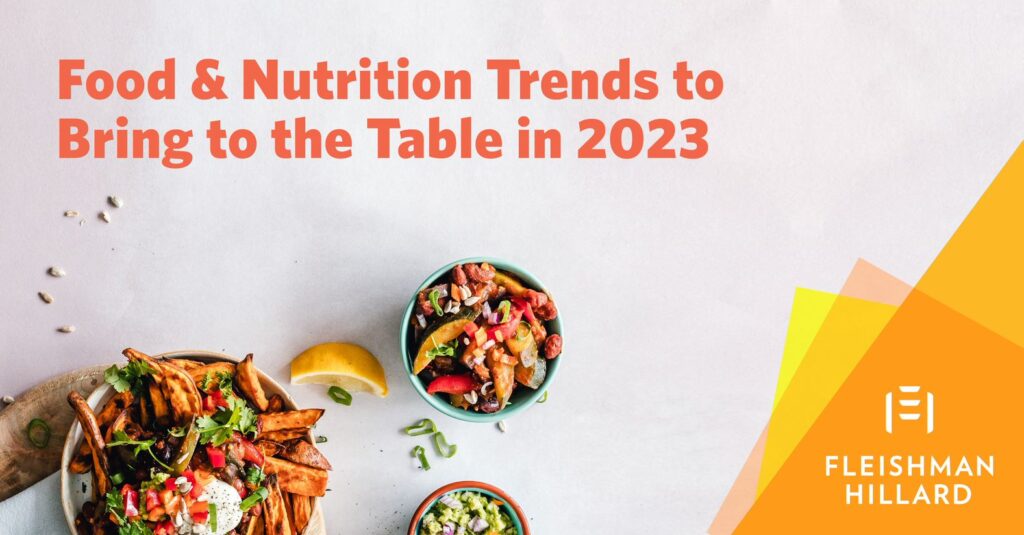Food & Nutrition Trends to Bring to the Table in 2023
As we close out another eventful food and beverage year, shoppers, consumers and foodies await the new trends for 2023. From butter boards to baked oats, plant-based innovations to sustainability goals, it’s our role to help clients navigate the ever-changing health and wellness landscape.
How will the new guardrails for “healthy” impact brand products? What actions will come to life as a result of the White House Conference on Hunger and Nutrition? Why does this matter? Our team of FleishmanHillard registered dietitians have expertise in nutrition communications and relationships with a network of dietitians and wellness professionals who can help build your food, beverage or nutrition strategy for 2023. Below is a snapshot of notable trends in 2022 and what’s on the table for next year:
INTENTIONAL FOOD CHOICES: Health remains top-of-mind for American consumers, with just over half of Americans (52%) following a specific diet or eating pattern. The top health benefits Americans are seeking include energy and less fatigue (37%), weight loss/management (30%), digestive/gut health (29%), heart/cardiovascular health (28%), improved sleep (26%) and immune function/health (25%). In particular, plant-based foods are a reoccurring focus mentioned amongst consumer trend reports. In fact, 60% of consumers say they prefer “plant-based foods that showcase the fruit or vegetable instead of mimicking another food,” compared to 40% who prefer plant-based options that replace traditional foods like beef or milk.
- What does this mean for me? Food and beverage companies should communicate their specific health- and nutrition-related benefits. And, when it comes to plant-based options, companies should consider whether it is appropriate to highlight their products as part of a plant-based diet.
RENEWED FOCUS + SCRUTINY ON NUTRITION: Health remains top of mind not only for consumers but for policy makers and the White House. During the first meeting of its kind in more than 50 years, the White House Conference on Hunger, Nutrition and Health shared a new national strategy for combating hunger, improving nutrition and physical activity, reducing diet-related disease by 2030 and focused on the twin problem of hunger and poor nutrition, which are often flip sides of the same coin.
On the same day, the Food and Drug Administration released a proposed rule for a new definition of the nutrient content claim healthy. The original claim is based on limiting nutrients of public health concern like saturated fat, cholesterol and sodium, and promoting nutrients to encourage such as certain vitamins and minerals the population fell short on during that time. Given the criteria was set almost 30 years ago, many agree with the need to update it, but whether the new criteria is the right approach is still up for debate.
- What does this mean for me? Under the current administration, food and beverage companies will need to continue to make nutrition a priority and showcase how they are helping to improve the quality and accessibility of the food supply. Certain foods once deemed healthy may not be in the future, so there will be a need to determine the implications and path forward both from a product development standpoint as well as marketing.
TECHNOLOGY TO MEET CONSUMER DEMANDS: The health and wellbeing of our planet is a high and growing priority with consumers – with demands for greater transparency and accountability. The 2022 IFIC Food and Health Survey Consumer Snapshot reported that 52% of consumers believe their food and beverage purchases have an impact on the environment, 57% are concerned about food waste, specifically Gen Z, Millennials and Gen X respondents, and the 2023 Innova survey found “60% of consumers said their trust in a brand increased when the brand clearly communicated challenges the product was facing.” To meet these demands, the food and beverage industry is turning to technology to solve everything from food production efficiency and alternative ingredients to information sharing via QR codes and virtual menus.
- What does this mean for me? While many food and beverage companies develop their sustainability goals internally, new technology enables companies to tailor their efforts externally to today’s consumers. From apps to food production, technology is evolving and companies must keep up with the changes and include their audience along the way.
If you’re looking for more food and nutrition insights, need help navigating the wellness landscape or developing your food and beverage strategy, we encourage you to reach out to our team of FleishmanHillard dietitians.

